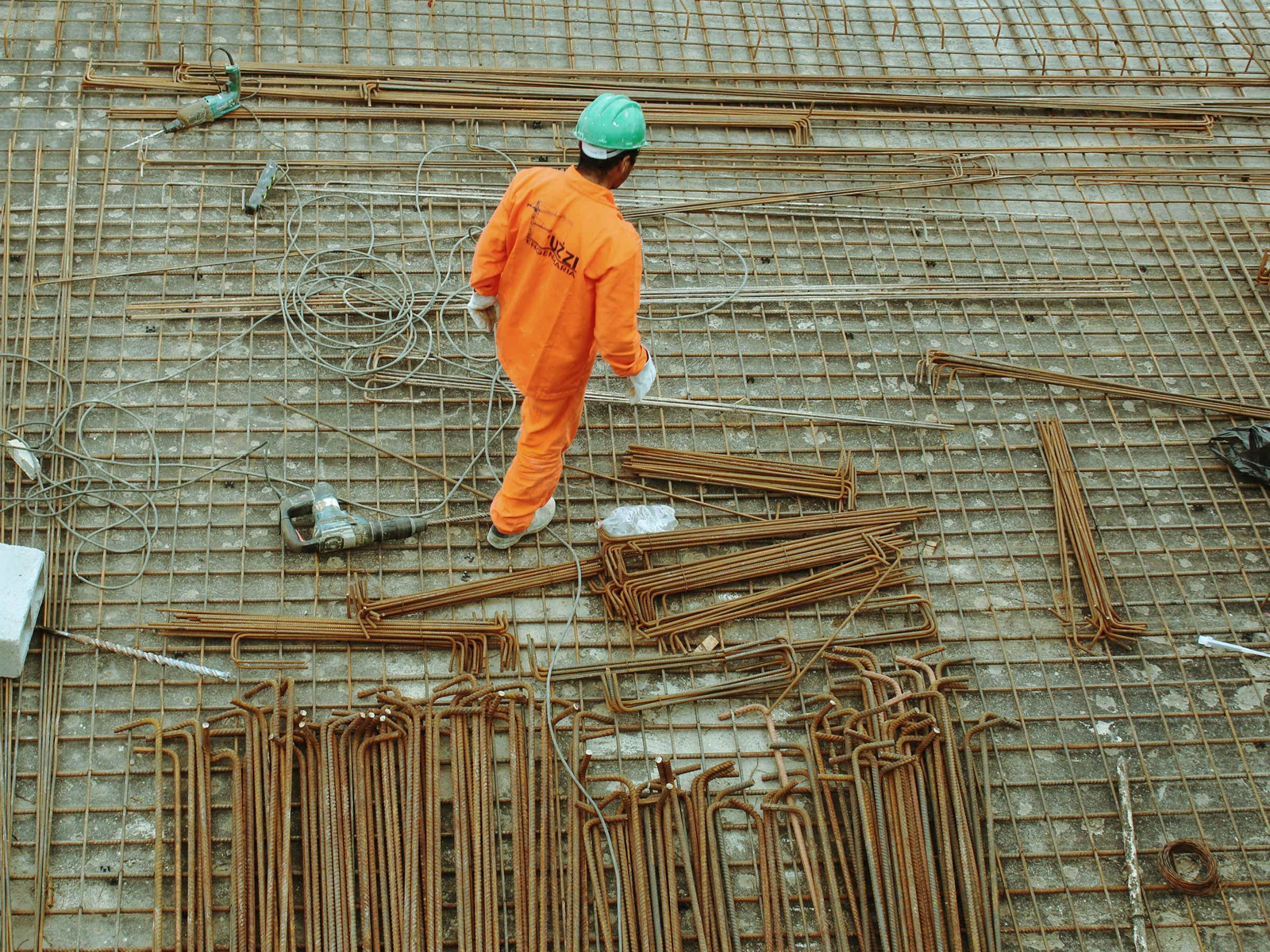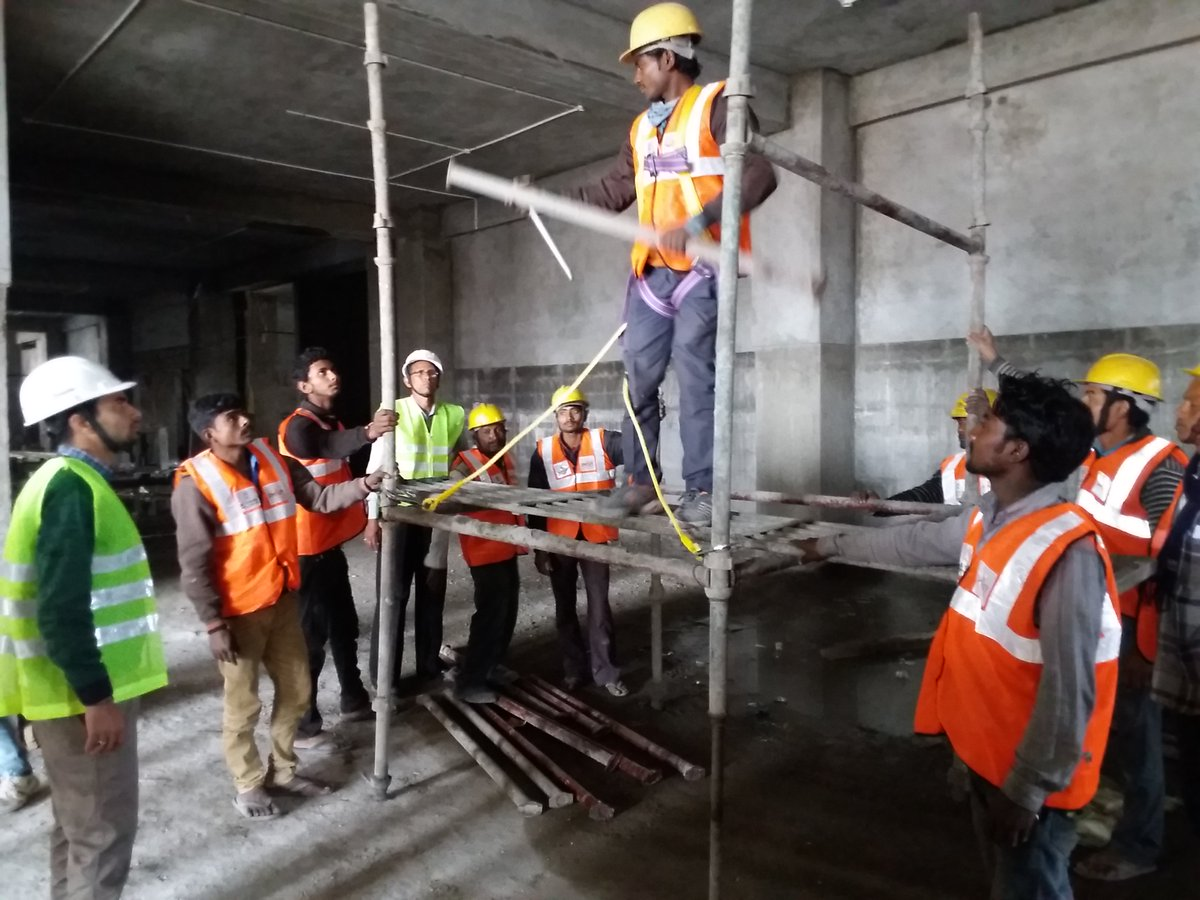Helper Bar Bender and Steel Fixer ( 6 month course)
Helper Bar Bender and Steel Fixer click here
Brief Job Description
This job role is responsible for identification, handling and use of materials, tools, and equipment. The
responsibilities also include identification, straightening, marking and cutting of rebar, tying reinforcement for prefabricated cages and at in-situ using hand tools.
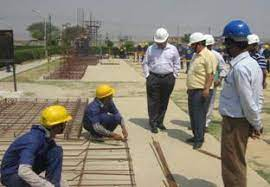
Personal Attributes
The individual is expected to be physically fit and should be able to work across various locations in
withstanding extreme conditions while working. The individual shall be able to work within a team to
handle various bar bending tools and materials and works under continuous instructions and close
supervision.
Identify, shift and stack materials, tools and equipment relevant to reinforcement works
Description
This unit describes the skills and knowledge required to identify, shift and stack materials, tools and
equipment relevant to reinforcement works under continuous instructions and close supervision.
Scope
The scope covers the following :
Identify, shift and stack materials, tools and equipment relevant to reinforcement works
Elements and Performance Criteria
Identify, shift and stack materials, tools and equipment relevant to reinforcement works
To be competent, the user/individual on the job must be able to:
PC1. identify materials such as binding wire, bar connecting coupler, thread protection cap &
reinforcement steel on basis of their type, diameter and grade
PC2. identify hand tools such as bending lever, hook, measurement tape, gauge, sledge hammer,
chisel, pin plate and other relevant tools used in reinforcement works
PC3. identify basic power tools such as hand held rebar cutting machine, circular rebar cutting
machine, rebar threading machine, shearing machine for rebar cutting , rebar bending
machine
PC4. identify personal protective gears and equipment such as safety shoes, gloves, helmets, ear
plugs, nose mask and safety goggles
PC5. identify different types of slings, shackles and lifting belts
PC6. identify full and half body safety harness
PC7. load, unload and shift and stack reinforcement steel as per standard practices
PC8. sort, tag, stack and store reinforcement steel as per type, grade, size and grade
PC9. protect reinforcement steel from corrosion and other weathering action
Knowledge and Understanding (KU)
The individual on the job needs to know and understand:
KU1. safety rules and regulations for handling and storing reinforcement tools, materials and
components
KU2. safety rules and regulations for handling and storing reinforcement tools,materials and
components
KU3. safe working methods and movements while performing relevant tasks
KU4. request procedure for tools & materials and equipment
KU5. housekeeping & other site administrative rules
KU6. types of reinforcement steel, their grade and size
KU7. types of binding wire
KU8. types and use of slings, shackles and lifting belts
KU9. visual checks for quality of materials
KU10. use of hand tools such as lever, hook, measuring tape, sledge hammer, chisel
KU11. types of cutting and bending machine
KU12. method of cutting reinforcement using hand tool
KU13. method of cutting and bending of rebar
KU14. importance of correct body posture
KU15. standard procedure for stacking of reinforcement
KU16. workplace procedure and policies for manual and mechanical handling
KU17. housekeeping standards procedures required in the workplace
KU18. position of overhead electrical wires and cables during shifting / lifting of materials
KU19. knowledge about storing and handling technique of tools
KU20. knowledge about upkeep repair and maintenance of tools
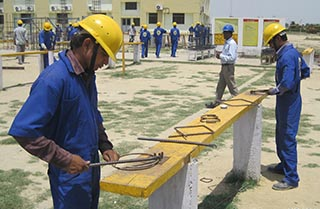
Generic Skills (GS)
User/individual on the job needs to know how to:
GS1. write in at least one language, preferably in the local language of the site
GS2. read in one or more language, preferably in the local language of the site
GS3. read instructions, guidelines, sign boards, safety rules & safety tags instructions related to
exit routes during emergency at the workplace
GS4. speak in one or more language, preferably in one of the local languages of the site
GS5. listen and follow instructions given by the superior
GS6. decide whether his workplace is safe for working
GS7. place materials in correct position near the job to ensure sufficient availability
GS8. identify location at which violation of any safety norms may lead to accidents
Identify, mark and cut reinforcement bar to required length
Description
This unit describes the skills and knowledge required to identify, straighten, mark and cut reinforcement
bar as per the requirement under continuous instructions and close supervision
Scope
The scope covers the following :
Identify, straighten, mark and cut reinforcement bar to required lengths
Elements and Performance Criteria
Identify, straighten, mark and cut reinforcement bar to required lengths
To be competent, the user/individual on the job must be able to:
PC1. identify hand tools such as bending lever, hook, measurement tape, gauge, sledge hammer,
chisels, hack saw
PC2. identify reinforcement bar of different types, grade and diameter
PC3. select and use bending lever and pipe for straightening of rebar of different diameter
PC4. mark cut lengths on reinforcement bar as per instructions
PC5. cut rebar of smaller diameter manually using chisel and sledge hammer as per requirement
PC6. cut rebar as specified/ instructed using hand cutting machine, circular cutting machine or
shearing machine
PC7. straight reinforcement bar with bends
PC8. straight reinforcement bar cut from the coils
PC9. tag cut reinforcement bar with cutting length and stack as per standard practices and
instructions
Knowledge and Understanding (KU)
The individual on the job needs to know and understand:
KU1. safety rules and regulations for handling and storing reinforcement tools, materials and
components
KU2. safety rules and regulations for handling and storing reinforcement tools, materials and
components
KU3. safe working methods and movements while performing relevant tasks
KU4. request procedure for tools & materials and equipment
KU5. housekeeping & other site administrative rules
KU6. various type of bar, their grades and diameter
KU7. use of hand tools for straightening of rebar
KU8. types and use of tools for cutting rebar manually
KU9. use of power tools for cutting of rebar
KU10. types of ties and use on different structural elements
KU11. use of measurement and marking tools
KU12. importance of sorting and stacking cut piece rebar on the basis of length and diameter
Generic Skills (GS)
User/individual on the job needs to know how to:
GS1. write in at least one language, preferably in the local language of the site
GS2. read in one or more language, preferably in the local language of the site
GS3. read instructions, guidelines, sign boards, safety rules & safety tags instructions related to
exit routes during emergency at the workplace
GS4. speak in one or more language, preferably in one of the local languages of the site
GS5. listen and follow instructions given by the superior
GS6. decide whether his workplace is safe for working
GS7. complete work as per agreed time schedule and quality
GS8. identify location at which violation of any safety norms may lead to accidents
Tie reinforcement bar using different types of ties
Description
This unit describes the skills and knowledge required to tie reinforcement bar usingdifferent types of ties
for various structural elements such as column, beams, slabs, footing, wall under continuous instructions
and close supervision
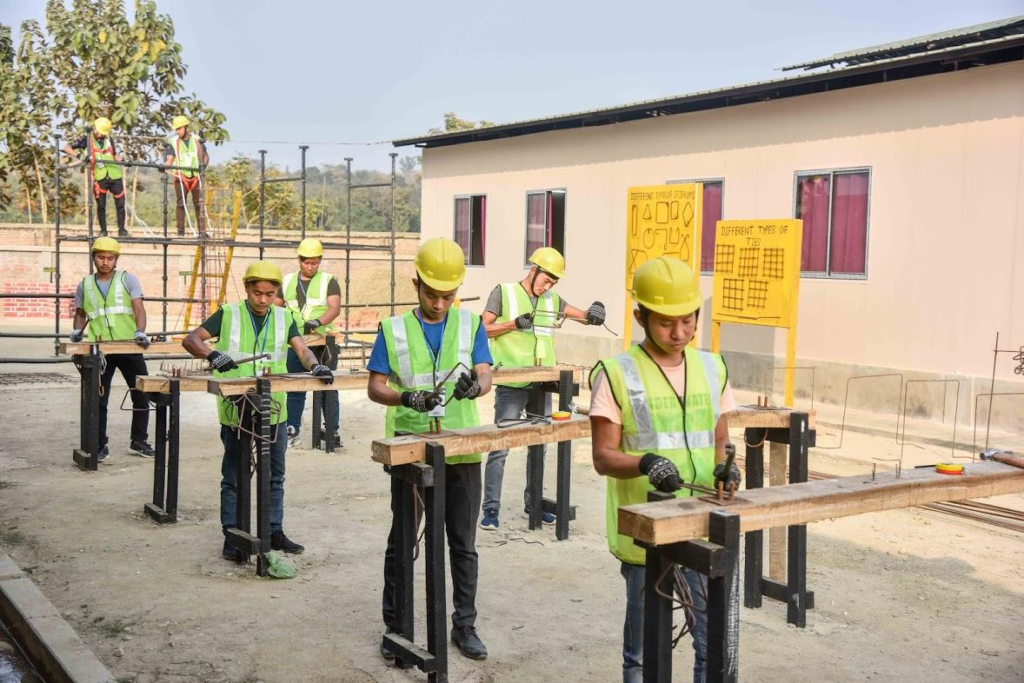
Scope
The scope covers the following :
Tie rebar using different types of ties
Elements and Performance Criteria
Tie rebar using different types of ties
To be competent, the user/individual on the job must be able to:
PC1. identify the different types of binding wires such as mild steel, galvanized iron wire
PC2. identify and use hand and power tools for tying of rebar
PC3. identify different types of ties such as slash tie, ring slash tie, hairpin tie, ring hairpin tie,
crown tie, splice tie
PC4. cut binding wire as per the requirement
PC5. tie reinforcement using slash tie and splash tie to prevent displacement of bar as per
requirement
PC6. maintain specified/instructed spacing while tying rebar
PC7. untie loosened reinforcement bar and secure its position using suitable tie
Knowledge and Understanding (KU)
The individual on the job needs to know and understand:
KU1. safety rules and regulations for handling and storing reinforcement tools, materials and
components
KU2. personal protection including use of safety gears and equipment
KU3. safe working methods and movements while performing relevant tasks
KU4. request procedure for tools & materials
KU5. housekeeping &other site administrative rules
KU6. identification and use of binding wire
KU7. identification and use of hand & power tools for reinforcement works
KU8. identification of rebar on basis of grade, type and diameter
KU9. physical property of binding wire
KU10. different types of ties such as slash tie, ring slash tie, hairpin tie, ring hairpin tie, crown tie,
splice tie
KU11. how to tie reinforcement using different types of ties
KU12. length of binding wire required for different types of ties
KU13. personal protective equipment for safety
KU14. how to barricade working area
KU15. importance of housekeeping
KU16. use of measurements and marking tools
Generic Skills (GS)
User/individual on the job needs to know how to:
GS1. write in at least one language, preferably in the local language of the site
GS2. read in one or more language, preferably in the local language of the site
GS3. read instructions, guidelines, sign boards, safety rules & safety tags instructions related to
exit routes during emergency at the workplace
GS4. speak in one or more language, preferably in one of the local languages of the site
GS5. listen and follow instructions given by the superior
GS6. decide whether his workplace is safe for working
GS7. complete work as per agreed time schedule and quality
GS8. minimize wastages of material
GS9. identify location at which violation of any safety norms may lead to accidents
Erect and dismantle temporary scaffold up to 3.6 meter height
Description
This unit describes the skills and knowledge required to erect and dismantle 3.6 meter temporary scaffold
Scope
The scope covers the following :
Erect and dismantle temporary scaffold up to 3.6 meter height
Elements and Performance Criteria
Erect and dismantle temporary scaffold up to 3.6 meter height
To be competent, the user/individual on the job must be able to:
PC1. level area where scaffold need to be erected and check for ground compactness if required
PC2. shift and stack required materials, components, tools and tackles at the instructed location
PC3. wear and use required safety gadgets and follow trade safety
PC4. place base plates and sole boards on the ground as per markings and instructions
PC5. use proper components and follow standard procedure for erecting temporary scaffold up to
3.6 m
PC6. check verticality of scaffold at first level of erection and correct (if required) before moving to
the next level
PC7. check for rigidity, stability and support of erected scaffold
PC8. fix walk-boards, guard rails, toe-boards and other components on working platform
PC9. follow standard procedure for dismantling of temporary scaffold up to 3.6 m
PC10. remove guard rails, toe boards, walk boards and other components sequentially
PC11. clean and stack all components properly after dismantling
PC12. maintain tidiness at work location
Knowledge and Understanding (KU)
The individual on the job needs to know and understand:
KU1. standard procedure for scaffolding works
KU2. safety rules and regulations for handling and storing scaffolding tools, materials and
components
KU3. personal protection including use of safety gears and equipment
KU4. request procedure for tools & materials
KU5. housekeeping & other administrative rules
KU6. use of different types of scaffolds (cup-lock , frame scaffold)
KU7. use of different types of scaffolds (cup-lock, frame scaffold)
KU8. use of tools and tackles in scaffolding works
KU9. identification and use of different components
KU10. use of tools for measurements and marking
KU11. basic arithmetic calculation
KU12. units of measurements
KU13. standard size of scaffolding components
KU14. personal protective equipment for safety
KU15. importance of housekeeping
KU16. standard procedure for erection and dismantling of 3.6 m temporary scaffold
KU17. tools and equipment used for erecting and dismantling 3.6 meter temporary scaffoild
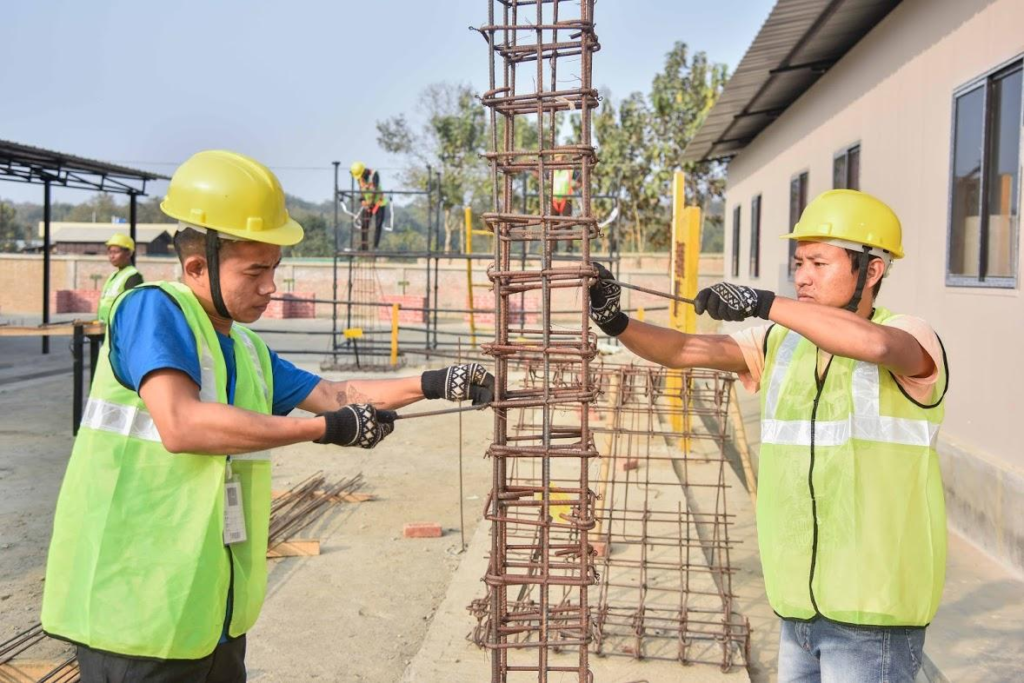
Generic Skills (GS)
User/individual on the job needs to know how to:
GS1. write in one or more language, preferably in the local language of the site
GS2. read one or more language, preferably the local language of the site
GS3. read instructions, guidelines, sign boards, safety rules & safety tags
GS4. speak in one or more language, preferably in one of the local languages of site
GS5. listen and follow instructions / communication shared by superiors/ co- workers regarding
team requirements or interfaces during work processes
GS6. orally communicate with co-workers regarding support required to complete the respective
work
GS7. decide whether the workplace is safe for working and also whether the
GS8. identify and organize right scaffolding materials
GS9. identify and use relevant tools effectively
GS10. complete work as per agreed time and quality
GS11. minimize wastages
GS12. revert to superior for selection/sorting of materials
GS13. identify location at which violation of any safety norms may lead to accidents
Work according to personal health, safety and environment protocol at construction site
Description
This NOS covers the skill and knowledge required for an individual to work according to personal health,
safety and environmental protocol at construction site
Scope
The scope covers the following :
Follow safety norms as defined by organization
Adopt healthy & safe work practices
Implement good housekeeping and environment protection process and activities
Elements and Performance Criteria
Follow safety norms as defined by organization
To be competent, the user/individual on the job must be able to:
PC1. identify and report any hazards, risks or breaches in site safety to the appropriate authority
PC2. follow emergency and evacuation procedures in case of accidents, fires, natural calamities
PC3. follow recommended safe practices in handling construction materials, including chemical
and hazardous material whenever applicable
PC4. participate in safety awareness programs like Tool Box Talks, safety demonstrations, mock
drills, conducted at site
PC5. select and operate different types of fire extinguishers corresponding to types of fires as per
EHS guideline
PC6. identify near miss , unsafe condition and unsafe act
Adopt healthy & safe work practices
To be competent, the user/individual on the job must be able to:
PC7. use appropriate Personal Protective Equipment (PPE) as per work requirements including:
Head Protection (Helmets), Ear protection, Fall Protection, Foot Protection, Face and Eye
Protection, Hand and Body Protection, Respiratory Protection (if required)
PC8. handle all required tools, tackles , materials & equipment safely
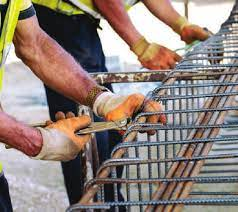
PC9. follow safe disposal of waste, harmful and hazardous materials as per EHS guidelines
PC10. install and apply properly all safety equipment as instructed
PC11. follow safety protocol and practices as laid down by site EHS department
PC12. undertake and pass height pass test as per EHS guideline
Implement good housekeeping and environment protection process and activities
To be competent, the user/individual on the job must be able to:
PC13. collect and deposit construction waste into identified containers before disposal, separate
containers that may be needed for disposal of toxic or hazardous wastes
PC14. apply ergonomic principles wherever required
Knowledge and Understanding (KU)
The individual on the job needs to know and understand:
KU1. reporting procedures in cases of breaches or hazards for site safety, accidents, and
emergency situations as per guidelines
KU2. types of safety hazards at construction sites
KU3. basic ergonomic principles as per applicability
KU4. the procedure for responding to accidents and other emergencies at site
KU5. use of appropriate personal protective equipment to be used based on various working
conditions
KU6. importance of handling tools, equipment and materials as per applicable
KU7. health and environmental effect of construction materials as per applicability
KU8. various environmental protection methods as per applicability
KU9. storage of waste including the following at appropriate location: non-combustible scrap
material and debris, combustible scrap material and debris, general construction waste and
trash (non-toxic, non-hazardous), any other hazardous wastes, any other flammable wastes
KU10. how to use hazardous material, in a safe and appropriate manner as per applicability
KU11. types of fire
KU12. Procedure of operating different types of fire extinguishers
KU13. safety relevant to tools, tackles, & requirement as per applicability
KU14. housekeeping activities relevant to task
Generic Skills (GS)
User/individual on the job needs to know how to:
GS1. write in one or more languages, preferably in the local language of the site
GS2. fill safety formats for near miss, unsafe conditions and safety suggestions
GS3. read in one or more language, preferably in the local language of the site
GS4. read sign boards, notice boards relevant to safety
GS5. speak in one or more language, preferably in one of the local language of the site
GS6. listen instructions / communication shared by site EHS and superiors regarding site safety,
and conducting tool box talk
GS7. communicate reporting of site conditions, hazards, accidents, etc.
GS8. maintain safe conditions for others
GS9. keep the workplace clean and tidy
GS10. identify safety risks that affect the health, safety and environment for self and others
working in the vicinity, tackle it if within limit or report to appropriate authority
GS11. assess and analyze areas which may affect health, safety and environment protocol on the
site
GS12. ensure personal safety behavior
GS13. respond to emergency
Carry out manual earthwork at construction site
Description
This unit describes the skills and knowledge required to carry out manual earthwork at construction sites
Scope
The scope covers the following :
Carry out preparatory work prior to earthwork
Carry out soil cutting, dressing work
Carry out backfilling and compaction manually
Elements and Performance Criteria
Carry out preparatory work prior to earthwork
To be competent, the user/individual on the job must be able to:
PC1. remove all the unwanted materials, organic substances, manually removable objects from
the worksite using appropriate hand tools as per instruction
PC2. clean earth surface using proper hand tools to make it ready for carrying out marking activity
PC3. carry out marking for excavation using lime, wooden pegs, ropes or by any other suitable
materials as per instruction
PC4. shift and stack fencing/ barricading materials, safety signage, ladders, ropes, earth cutting
and shifting tools at specified locations as per instruction
Carry out soil cutting, dressing work
To be competent, the user/individual on the job must be able to:
PC5. dig earth to a desired depth using appropriate tools as per instruction
PC6. maintain desired slope of earth during digging activity
PC7. dispose earth from the excavated pit by using suitable tools and equipments such as spade ,
wheel barrows, pans as per instruction
PC8. check for loose material, soil lumps, pebbles on achieving the desired earth level
PC9. carry out surface dressing work by disposing loose material, gravels, plant roots, sludge,
muck or debris as per requirement to the appropriate locations
PC10. carry out compaction of the base layer of the pit by ramming or operating hand/ plate
compactor as per instruction
Carry out backfilling and compaction manually
To be competent, the user/individual on the job must be able to:
PC11. shift and place earth at desired location by using right tools as per instruction
PC12. sort gravels or oversized aggregates from soil to be used for backfilling as per instruction
PC13. place and spread earth maintaining uniform layers within tolerance limit of thickness
PC14. sprinkle water as uniformly over the layer to be compacted as and when required as per
direction
PC15. carry out ramming or operate hand/ plate compacting machines over the soil layer as per
direction
PC16. carry out re-filling and compaction of excavated trenches, pits surrounding the structures or
at necessary location by soil under supervision
Knowledge and Understanding (KU)
The individual on the job needs to know and understand:
KU1. general safety rules applicable to different activities related to construction
KU2. administrative rules and regulations applicable to construction sites
KU3. material issue and return procedure at site
KU4. reporting procedures relevant to own job, unsafe/ hazardous conditions
KU5. use and name of hand tools such as spade, pick axe, shovel, pans, wheel
KU6. working at depth at below ground level
KU7. use of marking tools such as wooden pegs, lime, line threads, ropes
KU8. use of plate compactor, hand roller, earth ramming tools etc
KU9. how to maintain slope in excavation
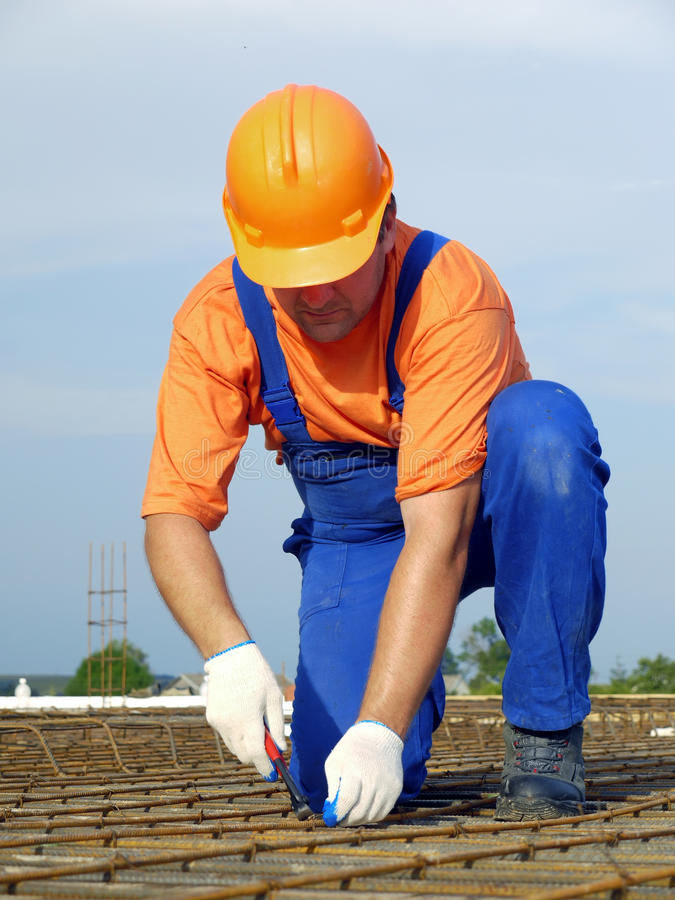
KU10. use of ladder to access earth pits
KU11. safety related to earthwork
Generic Skills (GS)
User/individual on the job needs to know how to:
GS1. write in at least one language, preferably in the local language of the site
GS2. read in one or more languages, preferably in the local language of the site
GS3. read instructions, guidelines, sign boards, safety rules & safety tags instruction related to
exit routes during emergency at the workplace
GS4. speak in one or more languages, preferably in one of the local languages of the site
GS5. listen and follow instructions / communication shared by superiors/ co- workers regarding
team requirements or interfaces during work processes
GS6. orally communicate with co-workers regarding support required to complete the respective
work
GS7. decide on tools to be used at different activities involved in manual
GS8. sequence activities to be carried out
GS9. decide whether his workplace is safe for working and also his work is not creating hazardous
conditions for other
GS10. identify and use the tools
GS11. identify and use of all safety equipment
GS12. arrange the material for earthwork
GS13. complete work as per time schedule and quality
GS14. determine any violation from organizational and standard safety norms


